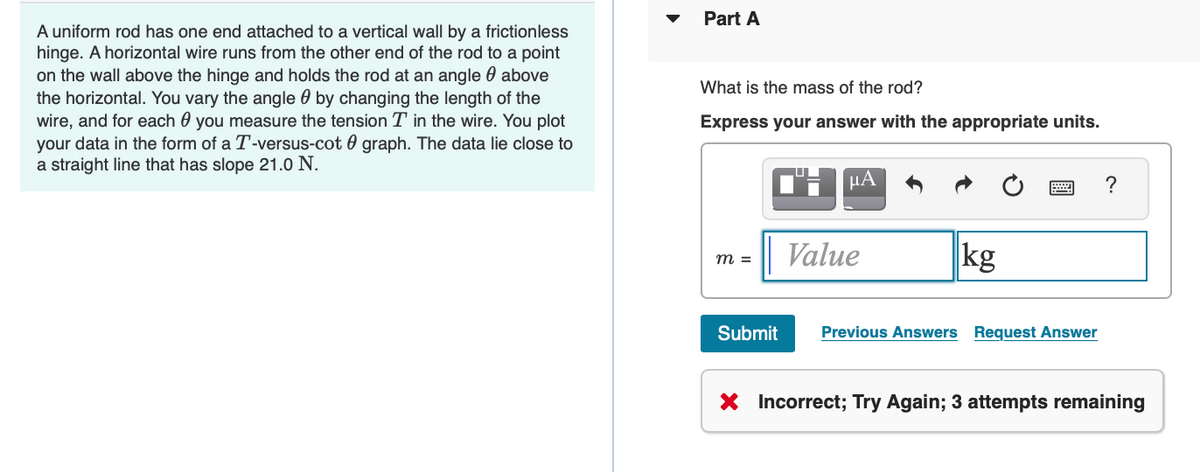A uniform rod has one end attached to a vertical wall by a frictionless hinge. A horizontal wire runs from the other end of the rod to a point on the wall above the hinge and holds the rod at an angle above the horizontal. You vary the angle by changing the length of the wire, and for each you measure the tension T in the wire. You plot your data in the form of a T-versus-cot graph. The data lie close to a straight line that has slope 21.0 N. Part A What is the mass of the rod? Express your answer with the appropriate units. CHHA m = Submit Value kg Previous Answers Request Answer ? X Incorrect; Try Again; 3 attempts remaining
A uniform rod has one end attached to a vertical wall by a frictionless hinge. A horizontal wire runs from the other end of the rod to a point on the wall above the hinge and holds the rod at an angle above the horizontal. You vary the angle by changing the length of the wire, and for each you measure the tension T in the wire. You plot your data in the form of a T-versus-cot graph. The data lie close to a straight line that has slope 21.0 N. Part A What is the mass of the rod? Express your answer with the appropriate units. CHHA m = Submit Value kg Previous Answers Request Answer ? X Incorrect; Try Again; 3 attempts remaining
Physics for Scientists and Engineers: Foundations and Connections
1st Edition
ISBN:9781133939146
Author:Katz, Debora M.
Publisher:Katz, Debora M.
Chapter14: Static Equilibrium, Elasticity, And Fracture
Section: Chapter Questions
Problem 82PQ
Related questions
Concept explainers
Rotational Equilibrium And Rotational Dynamics
In physics, the state of balance between the forces and the dynamics of motion is called the equilibrium state. The balance between various forces acting on a system in a rotational motion is called rotational equilibrium or rotational dynamics.
Equilibrium of Forces
The tension created on one body during push or pull is known as force.
Question
100%

Transcribed Image Text:A uniform rod has one end attached to a vertical wall by a frictionless
hinge. A horizontal wire runs from the other end of the rod to a point
on the wall above the hinge and holds the rod at an angle above
the horizontal. You vary the angle by changing the length of the
wire, and for each you measure the tension T in the wire. You plot
0
your data in the form of a T-versus-cot graph. The data lie close to
a straight line that has slope 21.0 N.
Part A
What is the mass of the rod?
Express your answer with the appropriate units.
m =
Submit
μA
Value
kg
Previous Answers Request Answer
?
X Incorrect; Try Again; 3 attempts remaining
Expert Solution
This question has been solved!
Explore an expertly crafted, step-by-step solution for a thorough understanding of key concepts.
This is a popular solution!
Trending now
This is a popular solution!
Step by step
Solved in 2 steps with 2 images

Knowledge Booster
Learn more about
Need a deep-dive on the concept behind this application? Look no further. Learn more about this topic, physics and related others by exploring similar questions and additional content below.Recommended textbooks for you

Physics for Scientists and Engineers: Foundations…
Physics
ISBN:
9781133939146
Author:
Katz, Debora M.
Publisher:
Cengage Learning

Principles of Physics: A Calculus-Based Text
Physics
ISBN:
9781133104261
Author:
Raymond A. Serway, John W. Jewett
Publisher:
Cengage Learning

Physics for Scientists and Engineers
Physics
ISBN:
9781337553278
Author:
Raymond A. Serway, John W. Jewett
Publisher:
Cengage Learning

Physics for Scientists and Engineers: Foundations…
Physics
ISBN:
9781133939146
Author:
Katz, Debora M.
Publisher:
Cengage Learning

Principles of Physics: A Calculus-Based Text
Physics
ISBN:
9781133104261
Author:
Raymond A. Serway, John W. Jewett
Publisher:
Cengage Learning

Physics for Scientists and Engineers
Physics
ISBN:
9781337553278
Author:
Raymond A. Serway, John W. Jewett
Publisher:
Cengage Learning

Physics for Scientists and Engineers with Modern …
Physics
ISBN:
9781337553292
Author:
Raymond A. Serway, John W. Jewett
Publisher:
Cengage Learning